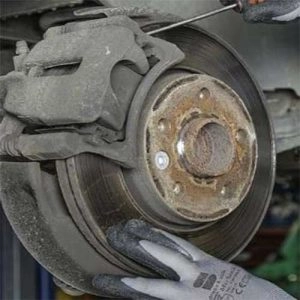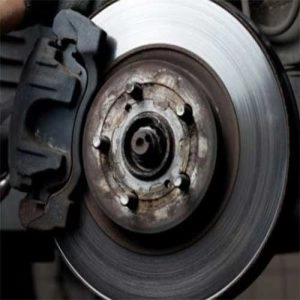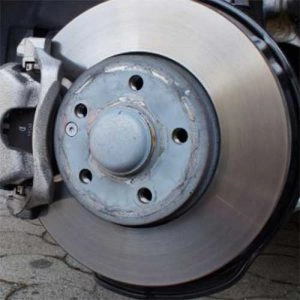Car hubs, also known as "rotors," represent metal discs that function synchronized with the brake calipers and brake pads to slow down the movement of the car. Their installation method is by mounting directly onto the wheel hub, allowing it to revolve with it, and when you press on the brake pedal, the brake caliper presses the brake pads onto the car hubs to slow down or stop the vehicle.
Hubs are parts of the car that require simple care and maintenance. It's important to perform regular maintenance to maintain good car performance. Maintenance might include changing the engine oil, occasionally checking the level of vital fluids, and adjusting the tire pressure appropriately. Maintenance requirements vary among different components and systems. We notice that some parts and components of the car require frequent and multiple maintenance, while other parts and components need simple maintenance a few times.
As for car brake maintenance, if you regularly check the fluids and replace the brake pads, that's good, but it's not 100% sufficient. This is because there are other aspects of the brake system that require attention, including the brake discs. It's known that brake discs work by directly rubbing against the brake pads to slow down the car, so they wear down over time and will eventually need to be replaced or repaired.
In this article, we will discuss hubs, explain their types, and highlight the signs indicating their damage.
Types of Car Hubs

Several types of hubs are used in car brakes, and here are some examples of the common kinds:
Smooth BrakesThese hubs are the standard for most cars, and they work to provide substantial stopping power for the vehicle. This is due to their larger surface area in contact with the brake lining, where friction increases as the surface area expands.
Slotted Brake Pads:These rotors feature hollow slots on their surface, making them suitable for heavy vehicles, such as four-wheel-drive cars, heavy-duty trucks, and cars that require good stopping power. These brakes contain slots designed to introduce a larger amount of air between the rotor and the lining, which increases cooling and helps dissipate heat.
This type of hub is also designed to eliminate dust formed from the brake pads. It is more effective than perforated hubs, but it leads to the accelerated wear of the brake lining.
Also read:The car's brakes come in 5 different types.
Perforated Hubs (Drilled):These brake pads are characterized by having drilled holes over their entire surface, which allows heat, dust, and water to pass through with greater ease. They are suitable for use in areas with a humid climate, as they are designed to help increase stopping power in rainy and humid conditions. However, they may not function well under high heat, and could potentially crack or break.
It should be noted that there are also other kinds of hubs available in the market, and these types vary in performance, cost, and requirements. The appropriate hubs should be chosen according to the vehicle's needs and the surrounding driving conditions. Among these types are the slotted and drilled rotors, and the floating rotors.
Cracked and Punctured Brake Pads:The perforated and slotted discs are specifically designed for high-performance cars, such as sports cars that require enhanced cooling and temperature reduction. They also contribute to improving the performance of the brakes at high speeds while driving the car on the racetrack.
Floating Brake Pads:Floating discs are composed of two parts, the first being the outer surface that rubs against the brake lining, and the second being the cap that is attached to the tire's axle. When the brakes are used continually, the surface of the hub remains hot, while the cap is less hot. If the surface of the hub becomes deformed due to the high heat, it is usually replaced on its own instead of changing the whole system. This contributes to lowering the maintenance cost. Additionally, most designs of floating brakes weigh less than a steel part design, which provides more comfort, a shorter stopping distance, and increased safety.
Signs of Car Hub Damage

Heat is generated as a result of friction, and over time, this heat, along with the climate and driving style, negatively affects the brake pads. Therefore, some people turn the rotors if they want to change the brake pads.
There are several signs indicating damage to the car's brake pads. It's crucial to pay attention and remember them if they appear in your car. These signs are:
Hearing strange noises when using the brakes:You may hear squeaking or noise when you use the brakes, and this is a common sign of poor brake discs. Deformed hubs can produce a squeaking sound, while heavily worn hubs can emit scraping noises. These noises may be produced due to some problem with the brake pads.
Feeling vibrations while using the brakes:This is another common sign of worn-out car brake pads, including significant vibration and shaking, or feeling a high intensity pulse when pressing the brake pedal or through the steering wheel. Sometimes you may feel the brake pedal thrusting if you press on it due to the distortion of the brake pads.

The presence of grooves on the surface of the brake discs:Which can appear due to repeated contact with the brake pads, and increase over time, leading to the cracking of the rotors.
Increasing the car's stopping distance:This is a very serious sign and can potentially lead to disastrous accidents. If the driver is forced to stop the car in an emergency, the stopping distance will be great if the limit has been exceeded.Car hubsThe provided text does not seem related to car maintenance and repair. In a typical general context, it translates to "Recommended for fish" in English. If you meant to provide text related to car maintenance and repair, please ensure to provide the correct text.

Comments